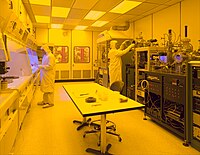
Photo from wikipedia
Abstract This study investigates the effect of thermal and mechanical processing of MnO2 nanoparticle cathodes on the electrochemical performance, ion intercalation mechanism and structural changes upon cycling. Thermal processing at… Click to show full abstract
Abstract This study investigates the effect of thermal and mechanical processing of MnO2 nanoparticle cathodes on the electrochemical performance, ion intercalation mechanism and structural changes upon cycling. Thermal processing at different temperatures is utilized to tune the sub-nanoparticle polymorph composition, while mechanical processing (high energy ball-milling) is used to change the particle size and create a better contact between active material and conductive graphite additive. The combination of thermal and mechanical processing is also investigated for possible synergistic effects. The structural changes due to processing suggest that thermal treatment of the MnO2 nanoparticles at 400 °C forms a high concentration of pyrolusite domains (1 × 1 channels) leading to improved reversibility of lithium intercalation/de-intercalation and capacity retention. It is also found that ball-milling for a short time (20 min) leads to some amorphization and decrease of the crystallite sizes resulting in improved capacity. The structural changes and ion intercalation mechanism of the pristine and processed electrode materials during cycling are investigated by ex situ synchrotron x-ray diffraction (XRD) and ex situ and in situ x-ray absorption near edge structure (XANES) studies.
Journal Title: Journal of Power Sources
Year Published: 2020
Link to full text (if available)
Share on Social Media: Sign Up to like & get
recommendations!